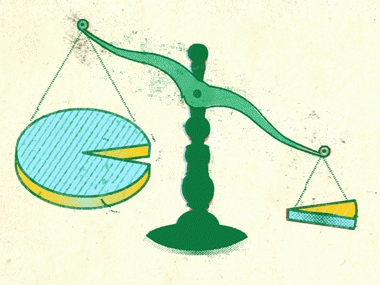Cross-posted from Robert Reich Blog
The pertinent question is not whether income and wealth inequality is good or bad. It is at what point do these inequalities become so great as to pose a serious threat to our economy, our ideal of equal opportunity and our democracy.
We are near or have already reached that tipping point. As French economist Thomas Piketty shows beyond doubt in his "Capital in the Twenty-First Century," we are heading back to levels of inequality not seen since the Gilded Age of the late 19th century. The dysfunctions of our economy and politics are not self-correcting when it comes to inequality.
But a return to the Gilded Age is not inevitable. It is incumbent on us to dedicate ourselves to reversing this diabolical trend. But in order to reform the system, we need a political movement for shared prosperity.
Herewith a short summary of what has happened, how it threatens the foundations of our society, why it has happened, and what we must do to reverse it.
What has Happened
The data on widening inequality are remarkably and disturbingly clear. The Congressional Budget Office has found that between 1979 and 2007, the onset of the Great Recession, the gap in income -- after federal taxes and transfer payments -- more than tripled between the top 1 percent of the population and everyone else. The after-tax, after-transfer income of the top 1 percent increased by 275 percent, while it increased less than 40 percent for the middle three quintiles of the population and only 18 percent for the bottom quintile.
The gap has continued to widen in the recovery. According to the Census Bureau, median family and median household incomes have been falling, adjusted for inflation; while according to the data gathered by my colleague Emmanuel Saez, the income of the wealthiest 1 percent has soared by 31 percent. In fact, Saez has calculated that 95 percent of all economic gains since the recovery began have gone to the top 1 percent.
Wealth has become even more concentrated than income. An April 2013 Pew Research Center report found that from 2009 to 2011, "the mean net worth of households in the upper 7 percent of wealth distribution rose by an estimated 28 percent, while the mean net worth of households in the lower 93 percent dropped by 4 percent."
Why It Threatens Our Society
This trend is now threatening the three foundation stones of our society: our economy, our ideal of equal opportunity and our democracy.
The economy -- In the United States, consumer spending accounts for approximately 70 percent of economic activity. If consumers don't have adequate purchasing power, businesses have no incentive to expand or hire additional workers. Because the rich spend a smaller proportion of their incomes than the middle class and the poor, it stands to reason that as a larger and larger share of the nation's total income goes to the top, consumer demand is dampened. If the middle class is forced to borrow in order to maintain its standard of living, that dampening may come suddenly -- when debt bubbles burst.
Consider that the two peak years of inequality over the past century -- when the top 1 percent garnered more than 23 percent of total income -- were 1928 and 2007. Each of these periods was preceded by substantial increases in borrowing, which ended notoriously in the Great Crash of 1929 and the near-meltdown of 2008.
The anemic recovery we are now experiencing is directly related to the decline in median household incomes after 2009, coupled with the inability or unwillingness of consumers to take on additional debt and of banks to finance that debt -- wisely, given the damage wrought by the bursting debt bubble. We cannot have a growing economy without a growing and buoyant middle class. We cannot have a growing middle class if almost all of the economic gains go to the top 1 percent.
Equal opportunity -- Widening inequality also challenges the nation's core ideal of equal opportunity, because it hampers upward mobility. High inequality correlates with low upward mobility. Studies are not conclusive because the speed of upward mobility is difficult to measure.
But even under the unrealistic assumption that its velocity is no different today than it was 30 years ago -- that someone born into a poor or lower-middle-class family today can move upward at the same rate as three decades ago -- widening inequality still hampers upward mobility. That's simply because the ladder is far longer now. The distance between its bottom and top rungs, and between every rung along the way, is far greater. Anyone ascending it at the same speed as before will necessarily make less progress upward.
(Note: You can view every article as one long page if you sign up as an Advocate Member, or higher).






